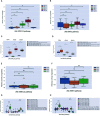Measurement of Cellular Immune Response to Viral Infection and Vaccination
- PMID: 33193365
- PMCID: PMC7604353
- DOI: 10.3389/fimmu.2020.575074
Measurement of Cellular Immune Response to Viral Infection and Vaccination
Abstract
Combined cellular and humoral host immune response determine the clinical course of a viral infection and effectiveness of vaccination, but currently the cellular immune response cannot be measured on simple blood samples. As functional activity of immune cells is determined by coordinated activity of signaling pathways, we developed mRNA-based JAK-STAT signaling pathway activity assays to quantitatively measure the cellular immune response on Affymetrix expression microarray data of various types of blood samples from virally infected patients (influenza, RSV, dengue, yellow fever, rotavirus) or vaccinated individuals, and to determine vaccine immunogenicity. JAK-STAT1/2 pathway activity was increased in blood samples of patients with viral, but not bacterial, infection and was higher in influenza compared to RSV-infected patients, reflecting known differences in immunogenicity. High JAK-STAT3 pathway activity was associated with more severe RSV infection. In contrast to inactivated influenza virus vaccine, live yellow fever vaccine did induce JAK-STAT1/2 pathway activity in blood samples, indicating superior immunogenicity. Normal (healthy) JAK-STAT1/2 pathway activity was established, enabling assay interpretation without the need for a reference sample. The JAK-STAT pathway assays enable measurement of cellular immune response for prognosis, therapy stratification, vaccine development, and clinical testing.
Keywords: JAK-STAT pathway; cellular immune response; signal transduction pathways; vaccine immunogenicity; viral infection.
Copyright © 2020 Bouwman, Verhaegh, Holtzer and van de Stolpe.
Figures








References
-
- Davis DM. The Beautiful Cure. Australia: Penguin Books; Available at: https://www.penguin.com.au/books/the-beautiful-cure-9781784702212 (Accessed 24-Aug-2020).
-
- coronavirus – Institute for the Future Available at: https://rega.kuleuven.be/if/corona_covid-19 (Accessed 24-Aug-2020).
Publication types
MeSH terms
Substances
LinkOut - more resources
Full Text Sources
Other Literature Sources
Medical
Research Materials
Miscellaneous

